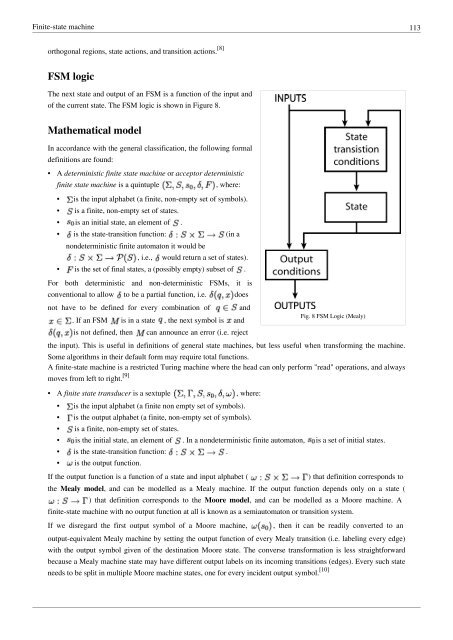Internet Protocol - Research by Kirils Solovjovs
Internet Protocol - Research by Kirils Solovjovs
Internet Protocol - Research by Kirils Solovjovs
Create successful ePaper yourself
Turn your PDF publications into a flip-book with our unique Google optimized e-Paper software.
Finite-state machine 113<br />
orthogonal regions, state actions, and transition actions. [8]<br />
FSM logic<br />
The next state and output of an FSM is a function of the input and<br />
of the current state. The FSM logic is shown in Figure 8.<br />
Mathematical model<br />
In accordance with the general classification, the following formal<br />
definitions are found:<br />
• A deterministic finite state machine or acceptor deterministic<br />
finite state machine is a quintuple , where:<br />
• is the input alphabet (a finite, non-empty set of symbols).<br />
• is a finite, non-empty set of states.<br />
• is an initial state, an element of .<br />
• is the state-transition function: (in a<br />
nondeterministic finite automaton it would be<br />
, i.e., would return a set of states).<br />
• is the set of final states, a (possibly empty) subset of .<br />
For both deterministic and non-deterministic FSMs, it is<br />
conventional to allow to be a partial function, i.e. does<br />
not have to be defined for every combination of and<br />
. If an FSM is in a state , the next symbol is and<br />
is not defined, then can announce an error (i.e. reject<br />
Fig. 8 FSM Logic (Mealy)<br />
the input). This is useful in definitions of general state machines, but less useful when transforming the machine.<br />
Some algorithms in their default form may require total functions.<br />
A finite-state machine is a restricted Turing machine where the head can only perform "read" operations, and always<br />
moves from left to right. [9]<br />
• A finite state transducer is a sextuple , where:<br />
• is the input alphabet (a finite non empty set of symbols).<br />
• is the output alphabet (a finite, non-empty set of symbols).<br />
• is a finite, non-empty set of states.<br />
• is the initial state, an element of . In a nondeterministic finite automaton, is a set of initial states.<br />
• is the state-transition function: .<br />
• is the output function.<br />
If the output function is a function of a state and input alphabet ( ) that definition corresponds to<br />
the Mealy model, and can be modelled as a Mealy machine. If the output function depends only on a state (<br />
) that definition corresponds to the Moore model, and can be modelled as a Moore machine. A<br />
finite-state machine with no output function at all is known as a semiautomaton or transition system.<br />
If we disregard the first output symbol of a Moore machine, , then it can be readily converted to an<br />
output-equivalent Mealy machine <strong>by</strong> setting the output function of every Mealy transition (i.e. labeling every edge)<br />
with the output symbol given of the destination Moore state. The converse transformation is less straightforward<br />
because a Mealy machine state may have different output labels on its incoming transitions (edges). Every such state<br />
needs to be split in multiple Moore machine states, one for every incident output symbol. [10]


